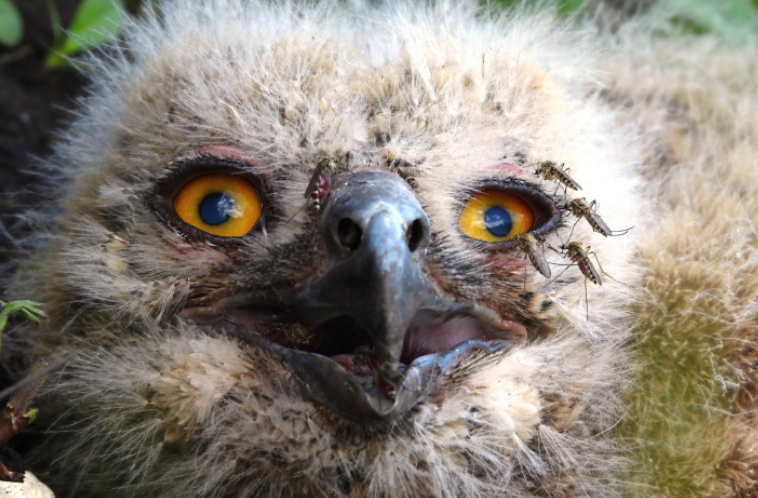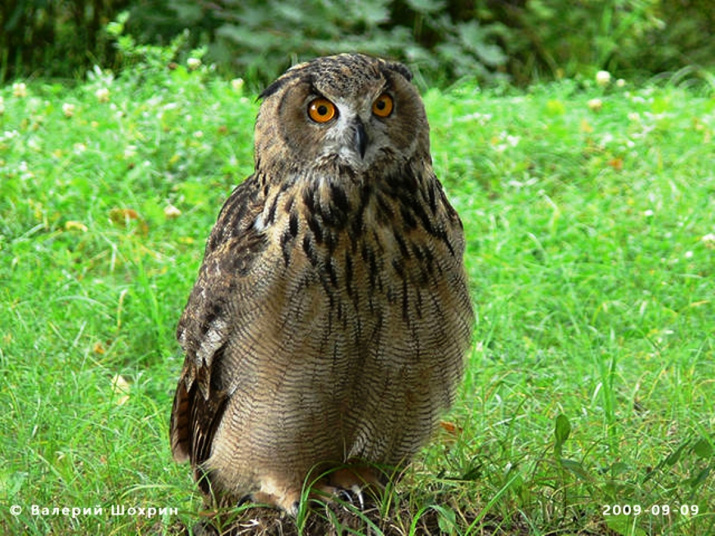Following the owl
IN THE FOOTSTEPS OF THE OWL

Filinenok ©Vladimir A. Sokolov
On May 12, 2023, the club of "Bird Keepers" of the phenological Commission of the Penza regional branch of the Russian Geographical Society conducted an expedition "In the footsteps of the owl" to the Kolyshlei district of the Penza region.
The owl (Bubo Bubo) is a very large owl almost the size of a goose (body length 60-75 cm, wingspan 160-190 cm, weight 2.0–3.3 kg). The facial disc is indistinct. A sitting bird holds its body vertically. The body is dense, "barrel-shaped", the sitting bird has large feathered "ears", so that it looks like a very large and thick-eared owl. In flight, as with all owls, a large head catches the eye, without cervical constriction. The wings are relatively long and wide, the owl looks a bit like a buzzard in the manner of flight. Usually the bird slowly and silently flies low above the ground, alternating waving flight with gliding. Leads a predominantly nocturnal lifestyle.
Category of rarity: 2 - widespread, sharply reduced by the end of the twentieth century. the number in most of the area, disappeared in places. The status of the owl, in most of Russia, remains unclear. The owl is listed in the Red Book of Russia and in the international Red Book.

Adult individual (photo from the Internet)
Habitat: uses hard-to-reach terrain areas in all natural zones (south of the forest tundra). He is settled everywhere, avoiding, as a rule, the proximity of a person. In extreme winters and in case of crop failure, forage makes local migrations, regular at the edges of the range.It has a high biotopic demand - up to 100 km2. Puberty - at the age of 2 years. It nests on the ground, on slopes and cliffs, on rock outcrops, uses nesting platforms of birds of prey, large hollows (forest zone), abandoned buildings, ruins.The average clutch consists of 2-3 eggs, rarely of 5. Incubation is 34-35 days, feeding in the nest for 60 days. The young ones stay for a long time in the areas of adult birds. The success of reproduction is determined by the conditions of the previous wintering, the feeding capacity of biotopes and the influence of the anxiety factor. The maximum life expectancy is 15-25 years. The dispersion distance of the young is 25-35 km. There is no food specialization, the range of nutrition - from fish, amphibians, birds, various species of small mammals to young ungulates.The most interesting feature of the owl is its ability to turn its head 270°. The owl, like the owl, has always evoked a dual attitude. On the one hand, it is a symbol of wisdom, secret knowledge. And on the other — the personification of dark forces. One historical fact is interesting. It is believed that the Romans lost the battle to Hannibal at Cannae largely due to the fact that at night owls screamed in their camp. This was considered a bad sign, and the fighting spirit of the soldiers left much to be desired.Protection: Listed in Annex 2 of CITES, Annex 2 of the Berne Convention, Annex of the agreement concluded by Russia with the Republic of Korea on the protection of migratory birds. It is protected in many state reserves and nature reserves. It is necessary to develop a comprehensive scientific program to determine the status and number of subspecies and populations of the owl in Russia, to create local and state sanctuaries with a seasonal ban (during the breeding season) on carrying out all types of forest, household work and recreation no closer than 200-300 meters from the nests in the breeding grounds of the owl in anthropogenic landscapes and in areas of increased attendance, to form a positive attitude towards nocturnal birds of prey on the part of the population, focusing on their rarity and vulnerability.

Nest found on the ground © Vladimir. A. Sokolov
- We left Penza at 9:00. The weather dictated its conditions in the morning - in places a south wind blew from 5 to 9 m / s, the temperature ranged from +20 to +22 ° C. On the way we met field sparrows, yellow wagtails, gray crows, rooks, black kites, sparrow owl, village swallows, meadow chekan and other birds. When we reached the meeting place, we saw two owl chicks, no adults were observed. The chicks were sitting on the ground and catching mosquitoes. When examining the place (imaginary nest) on the outskirts of the ravine, no food remains were observed. One chick pretended to be "dead", and the second hissed. We took two shots and retreated from the nest, so as not to disturb the chicks and not to worry, - said Vladimir Sokolov.

Filinata ©Vladimir A. Sokolov
Data on the fact of nesting and in order to preserve the species were transferred to the Department of Rosprirodnadzor for the Saratov and Penza regions. All participants of the expedition received certificates of participation.Prepared by: Vladimir Sokolov, Chairman of the Phenological Commission. photo material of the members of the "Keepers of Birds" club